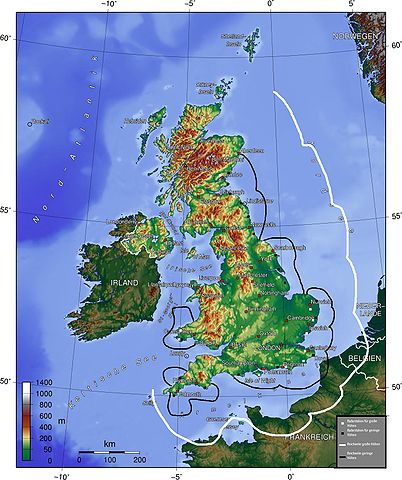 |
This is a file from the Wikimedia Commons. Information from its description page there is shown below.
Commons is a freely licensed media file repository. You can help.
|
The map (topographic background derived from a German article about Great Britain taken from German wikipedia) gives a quick overview about British radar facilities during the Battle for Britain 1940. I drew the map myself (thats the reason, why it looks quite improvised). Nasiruddin 16:27, 15 August 2005 (UTC)
- Explanation of German legend: White squares indicate high-altitude radar stations, black squares, low-altitude stations. The white line indicates the range of the high-altitude radar, the black line, the range of the low altitude radar.
-
- other versions =



 |
The map has been created with the Generic Mapping Tools: http://gmt.soest.hawaii.edu/ using one or more of these public domain datasets for the relief:
- ETOPO2 ( topography/ bathymetry): http://www.ngdc.noaa.gov/mgg/global/global.html
- GLOBE ( topography): http://www.ngdc.noaa.gov/mgg/topo/gltiles.html
- SRTM ( topography): http://www2.jpl.nasa.gov/srtm/
|
 |
Permission is granted to copy, distribute and/or modify this document under the terms of the GNU Free Documentation License, Version 1.2 or any later version published by the Free Software Foundation; with no Invariant Sections, no Front-Cover Texts, and no Back-Cover Texts. A copy of the license is included in the section entitled GNU Free Documentation License. http://www.gnu.org/copyleft/fdl.htmlGFDLGNU Free Documentation Licensetruetrue
|
File usage
The following pages on Schools Wikipedia link to this image (list may be incomplete):
You can learn about nearly 6,000 different topics on Schools Wikipedia. The world's largest orphan charity, SOS Children's Villages brings a better life to more than 2 million people in 133 countries around the globe. Would you like to sponsor a child?





